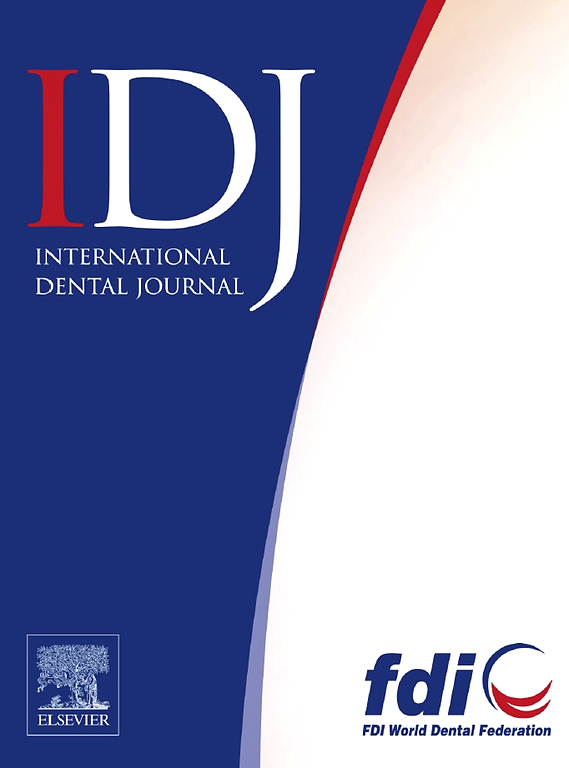牙齿异常:患病率、关联模式及与牙龄的关系
IF 3.7
3区 医学
Q1 DENTISTRY, ORAL SURGERY & MEDICINE
引用次数: 0
摘要
背景:牙齿畸形是口腔正畸和儿童牙科的常见发现,通常导致功能和美学问题。虽然其病因是多因素的,但遗传因素的作用越来越被认识到。目的确定牙齿异常的患病率,并确定可能提示共同遗传起源的相关模式。研究设计:本观察性、横断面回顾性研究分析了2个正畸诊所和1个儿科牙科诊所患者的全景x线照片。纳入标准排除先前因外伤、龋齿或拔牙、综合征、全身性疾病或颅面畸形而导致牙齿脱落的病例。描述性统计与层次聚类分析和推理检验相结合,以95%置信区间(IC)确定异常之间的关联。p值为<; 0.05被认为具有统计学意义。结果获得相应记录1904例,平均年龄10.69±5.06 años。牙畸形发生率为35.5%,其中以上侧切牙颌下畸形(9.3%)和上犬牙腭嵌塞(9.2%)最为常见。10.4%的患者出现多发性异常。发现了五种相关模式,其中最强的联系是上侧切牙下颌缺损和上颌牙的腭嵌塞(p < .001)。结论本研究为牙畸形共发提供了新的认识,支持了共同遗传因素假说。确定的模式有助于在正畸计划中早期发现和风险预测。临床相关性通过聚类分析识别牙齿异常的关联模式可以早期发现相关疾病,例如预测侧切牙下颌嵌塞,改善儿科和正畸患者的正畸诊断,治疗计划和预防策略。本文章由计算机程序翻译,如有差异,请以英文原文为准。
Dental Anomalies: Prevalence, Patterns of Association and Relationship With Dental Age
Background
Dental anomalies represent frequent findings in orthodontics and pediatric dentistry, often leading to functional and esthetic problems. Although their etiology is multifactorial, the role of genetic factors is increasingly recognised.
Objective
To determine the prevalence of dental anomalies and identify associative patterns that may suggest a shared genetic origin.
Study Design
This observational, cross-sectional retrospective study analysed panoramic radiographs from patients attending 2 orthodontic and one pediatric dentistry practices. Inclusion criteria excluded cases with prior tooth loss due to trauma, caries, or extractions, syndromes, systemic diseases, or craniofacial malformations. Descriptive statistics were combined with hierarchical cluster analysis and inferential tests to identify associations between anomalies with 95% confidence intervals (IC). A p value of<.05 was considered statistically significant.
Results
Records were obtained corresponding to 1,904 patients with a mean age of 10.69 5.06 años. Dental anomalies were found in 35.5% of patients, with hypodontia of upper lateral incisors (9.3%) and palatal impaction of upper canines (9.2%) being the most frequent. Multiple anomalies occurred in 10.4% of patients. Five associative patterns were identified, with the strongest link observed between upper lateral incisor hypodontia and palatal impaction of upper canines (p < .001).
Conclusions
This large-scale study provides new insights into the co-occurrence of dental anomalies, supporting the hypothesis of common genetic factors. The identified patterns may facilitate early detection and risk prediction in orthodontic planning.
Clinical Relevance
Identifying associative patterns of dental anomalies through cluster analysis enables early detection of related conditions, such as predicting canine impaction from lateral incisor hypodontia, improving orthodontic diagnosis, treatment planning, and preventive strategies in pediatric and orthodontic patients.
求助全文
通过发布文献求助,成功后即可免费获取论文全文。
去求助
来源期刊

International dental journal
医学-牙科与口腔外科
CiteScore
4.80
自引率
6.10%
发文量
159
审稿时长
63 days
期刊介绍:
The International Dental Journal features peer-reviewed, scientific articles relevant to international oral health issues, as well as practical, informative articles aimed at clinicians.
 求助内容:
求助内容: 应助结果提醒方式:
应助结果提醒方式:


